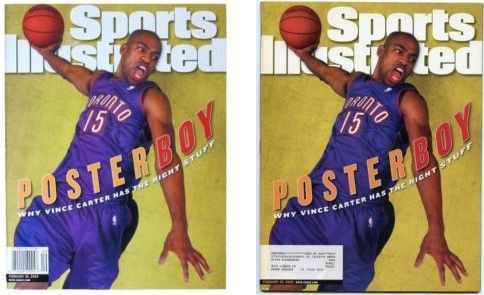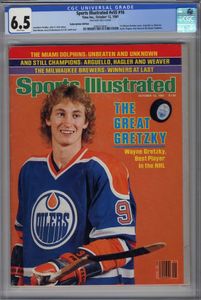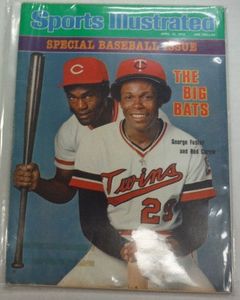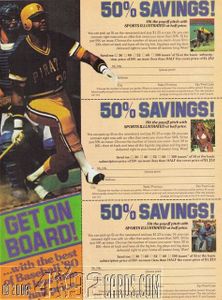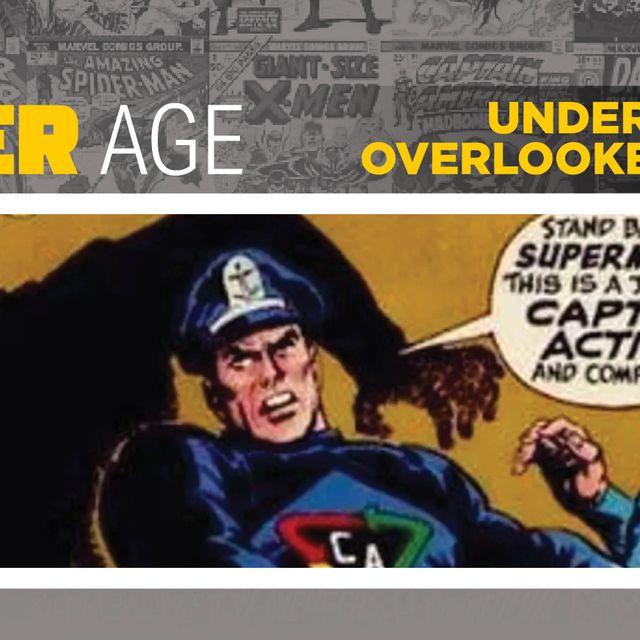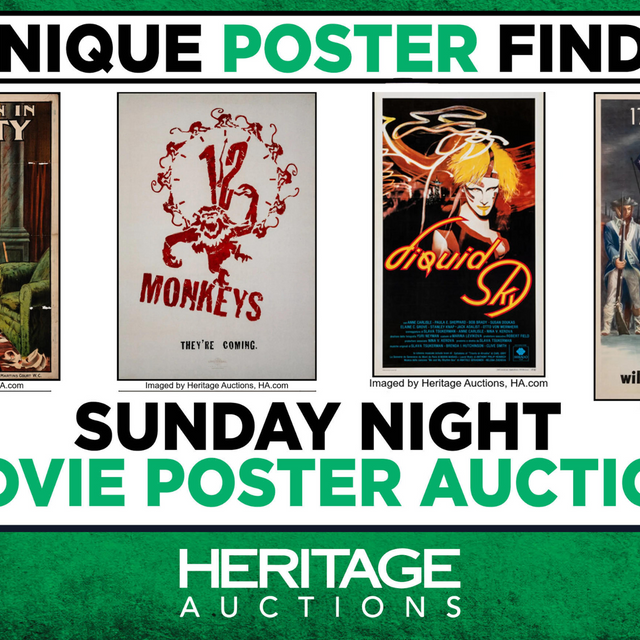
The grading of sports magazines, especially Sports Illustrated, continues to be a growing hobby in the realm of sports collectibles. A major component in the collectability of these items is the rarity of high-grade newsstand issues. In case you’re unfamiliar with what I’m talking about, let’s do a quick review.
Sports Illustrated was a weekly magazine publication from 1954-2018 that established itself as a leader in both sports journalism and photography. During that period, Sports Illustrated transformed into a cultural staple that sat on the coffee table of seemingly every sports-loving household. The magazine still exists, but now only releases printed issues monthly, and distributes to only a fraction of the subscribers that it did in its heyday.
Copies of the magazine that were delivered to subscribers are known as “subscription issues” and contained mailing labels on the front cover. Newsstand issues, on the other hand, were purchased directly from the store and never had a mailing label on the cover. Due to the large subscriber base of SI customers, the subscription copies are numerous. But the newsstand copies, especially vintage issues from the 50s/60s/70s, can be very difficult to find. And these newsstand issues are the ones that can really command premium value.
So what exactly denotes that a Sports Illustrated magazine is a newsstand copy versus a subscription copy? Unfortunately, it’s not always 100% straightforward, so let’s go over some key things to look for.
Modern Issues
Here’s the good news. For any Sports Illustrated from 1995-present, determining a newsstand is very easy. It was sometime in 1993-1994 that Sports Illustrated transitioned from printing subscription labels on a sticker to printing them directly on the front cover. Now, they didn’t just make this hard change all at once…it was somewhat staggered. So while some subscription issues in 1993/1994 had the printed mailing label on the cover, others still contained the sticker mailing label.
But once you get to 1995, pretty much any subscription label you will find is printed directly on the magazine cover. Therefore 1995-present means…mailing label = subscription. No mailing label = newsstand. Simple.
Copies with Mailing Label Stickers
For all of the Sports Illustrated issues from 1954-circa 1994, it’s a little bit trickier. Of course, in many cases, it is still extremely obvious and easy to spot a subscription issue with a mailing label, such as with this Michael Jordan issue from 1991.

But where the challenges arise is whenever sellers remove the mailing label. A label removed does not automatically change a magazine from a subscription issue to a newsstand. In fact, 99% of the time, CGC will detect when a label has been removed, and properly notate that issue to be a subscription. A perfect example is this CGC 6.5 Wayne Gretzky first cover shown below.
When glancing at the cover inside the slab, it looks as clean as a whistle and would suggest to be a newsstand. However, take a look at CGC’s labeling up top. Right in the middle, and just a little to the left, you’ll see the dreaded words: “Subscription Edition”. This means that a label has clearly been removed from the cover, thus dashing the overall value and collectability of this particular copy.
The good news is that MOST of the time, there are visible indicators on a cover to show if a magazine was a subscription copy with the label removed. Let’s take a look at some more examples.
Label Remnants
This Hank Aaron cover has what I classify as “label remnants”. Though there is no longer an entire mailing label on this cover, it is obvious that one existed and still partially remains. This is plainly a subscription issue.

Glue Streaks
One of the most tell-tale signs that you’re looking at a label-removed-subscription-issue is when you can see two strips of glue residue. These two glue strips were the adhesive used to attach the mailing labels onto the covers. It is extremely difficult for even the most talented label removers to erase every trace of these glue streaks.
For those that try, it often results in loss of color or paper. But when you are scanning issues for potential newsstand copies, be sure to look very, very carefully for any sign of these glue streaks that would denote a subscription issue.
This SI cover featuring George Foster and Rod Carew has two glue streaks near the bottom left corner, indicating that it is a subscription copy with the label removed.
Almost No Trace
There are a few individuals that have gotten so good at removing labels that they can barely be detected. In these cases, it may only be the slightest discoloration that gives it away. Or sometimes you may not even be able to see anything at all. Anytime I receive a magazine that I think is a newsstand, I slowly rub my finger along the edges to feel for any unusual spots. There have been several instances where I haven’t been able to initially see anything, but I could feel that there had indeed been a label removed.
If you are buying online, ALWAYS read the item description. You will often see magazines that look like newsstands in the photos, but are described by the seller as having the label “cleanly removed”. Once again, though the visual appeal may be strong, CGC will essentially always catch this and will label the magazine as a subscription edition, thus reducing the value.
Subscription Inserts
One indicator that can be somewhat helpful in determining a newsstand is if the magazine still has subscription inserts inside the pages. If you remember, the subscription inserts were smaller square/rectangle cutouts, often perforated but sometimes laying loose, where a buyer could sign up and mail-in an order for a new subscription. There were usually 2 or 3 of these located inside of each newsstand magazine. If I have a Sports Illustrated in my hands that I’m pretty sure is a newsstand, and then I locate subscription inserts still inside, that makes me feel even more confident that I do indeed have a newsstand.
Unfortunately, there are two downsides to this technique. First, the subscription inserts could have very easily been pulled out by a previous owner. So the absence of subscription inserts does not necessarily confirm that an issue isn’t a newsstand. Second, there are some cases where even a subscription issue may contain these inserts. For example, if a current subscriber was down to one of their last issues before their subscription expired, these inserts may have been put inside to encourage the reader to renew. Therefore, the presence or absence of these subscription inserts does not actually confirm anything.
One way or the other, it’s just an extra thing that I like to look at in conjunction with the search for a mailing label on the cover. If the cover looks clean, and subscription inserts are inside the magazine, more often than not it is indeed a newsstand.
Here is a sample of what subscription inserts would often look like inside of a Sports Illustrated.
Blank Box Subscriptions
There is one more scenario that we need to address. Blank box subscriptions. Remember how we said that modern issues from 1995-present always have the mailing label printed directly on the cover? Well, you will also see some covers from this period that have blank white boxes on the front. These blank boxes are where the name/address would typically have been printed, but it’s just an empty white box instead. Are these still considered subscription issues? Yes. But do these blank box subscriptions carry a bit more value and collectability than a traditional subscription issue with someone’s name and address printed on? Sales prices would indicate yes to this question as well.
The blank box issues were generated when, similar to what was mentioned earlier, a subscriber was down to the end of their subscription. Sports Illustrated would often put a rip-away cover on the outside of the magazine, warning that the subscription was nearly up and asking the customer to renew. Or they would also sometimes use these covers for various promotions and giveaways.
In these instances, the address was actually printed on the outside rip-away cover, but the actual magazine itself would have these blank boxes. Though they are still classified subscription issues by CGC, the aesthetic is a bit improved without someone’s name/address printed on the cover, and I have seen sales for blank box subscriptions come in anywhere between 15-50% of a newsstand at the same grade.
Summary
It can sometimes be frustrating trying to determine whether or not an issue in question is a newsstand or a subscription. But truthfully, this is one component of the sports magazine hobby that is extremely unique compared to other hobbies and really adds some extra fun to the hunt.
Over 90% of the magazines that you find for sale are typically subscription copies, so when you finally find a big newsstand magazine, the score is that much sweeter. Just make sure you keep all of the above scenarios in mind when you begin scavenging for Sports Illustrateds!

